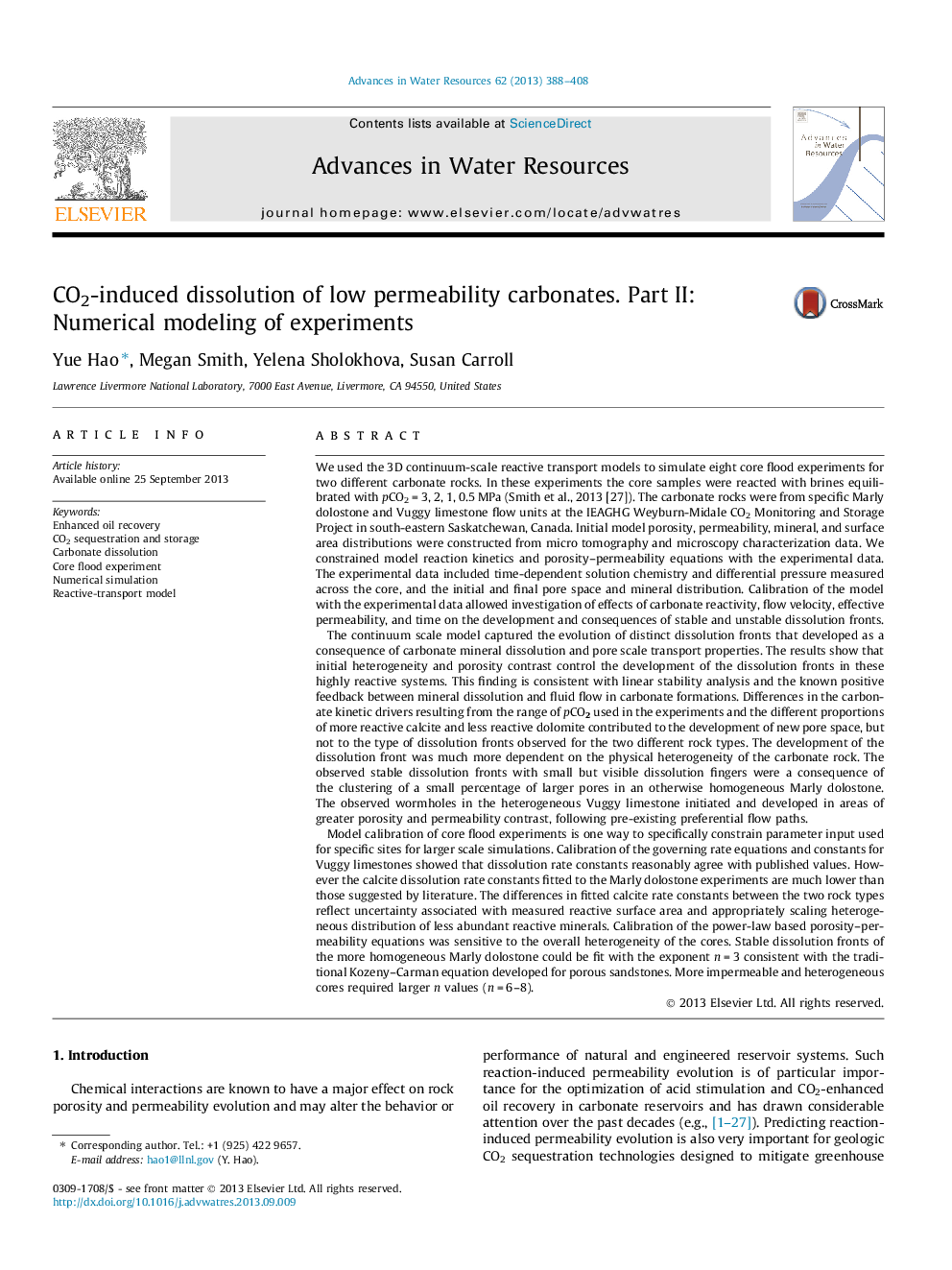| Article ID | Journal | Published Year | Pages | File Type |
|---|---|---|---|---|
| 6381119 | Advances in Water Resources | 2013 | 21 Pages |
â¢We simulated eight CO2 core flood experiments for two different carbonate rocks.â¢Continuum-scale reactive transport models were calibrated with the experimental data.â¢We studied key factors that affect mineral dissolution and reactive transport.â¢The continuum-scale model is able to capture the evolution of dissolution fronts.â¢The porosity-permeability relationship is sensitive to the core heterogeneity.
We used the 3D continuum-scale reactive transport models to simulate eight core flood experiments for two different carbonate rocks. In these experiments the core samples were reacted with brines equilibrated with pCO2 = 3, 2, 1, 0.5 MPa (Smith et al., 2013 [27]). The carbonate rocks were from specific Marly dolostone and Vuggy limestone flow units at the IEAGHG Weyburn-Midale CO2 Monitoring and Storage Project in south-eastern Saskatchewan, Canada. Initial model porosity, permeability, mineral, and surface area distributions were constructed from micro tomography and microscopy characterization data. We constrained model reaction kinetics and porosity-permeability equations with the experimental data. The experimental data included time-dependent solution chemistry and differential pressure measured across the core, and the initial and final pore space and mineral distribution. Calibration of the model with the experimental data allowed investigation of effects of carbonate reactivity, flow velocity, effective permeability, and time on the development and consequences of stable and unstable dissolution fronts.The continuum scale model captured the evolution of distinct dissolution fronts that developed as a consequence of carbonate mineral dissolution and pore scale transport properties. The results show that initial heterogeneity and porosity contrast control the development of the dissolution fronts in these highly reactive systems. This finding is consistent with linear stability analysis and the known positive feedback between mineral dissolution and fluid flow in carbonate formations. Differences in the carbonate kinetic drivers resulting from the range of pCO2 used in the experiments and the different proportions of more reactive calcite and less reactive dolomite contributed to the development of new pore space, but not to the type of dissolution fronts observed for the two different rock types. The development of the dissolution front was much more dependent on the physical heterogeneity of the carbonate rock. The observed stable dissolution fronts with small but visible dissolution fingers were a consequence of the clustering of a small percentage of larger pores in an otherwise homogeneous Marly dolostone. The observed wormholes in the heterogeneous Vuggy limestone initiated and developed in areas of greater porosity and permeability contrast, following pre-existing preferential flow paths.Model calibration of core flood experiments is one way to specifically constrain parameter input used for specific sites for larger scale simulations. Calibration of the governing rate equations and constants for Vuggy limestones showed that dissolution rate constants reasonably agree with published values. However the calcite dissolution rate constants fitted to the Marly dolostone experiments are much lower than those suggested by literature. The differences in fitted calcite rate constants between the two rock types reflect uncertainty associated with measured reactive surface area and appropriately scaling heterogeneous distribution of less abundant reactive minerals. Calibration of the power-law based porosity-permeability equations was sensitive to the overall heterogeneity of the cores. Stable dissolution fronts of the more homogeneous Marly dolostone could be fit with the exponent n = 3 consistent with the traditional Kozeny-Carman equation developed for porous sandstones. More impermeable and heterogeneous cores required larger n values (n = 6-8).
